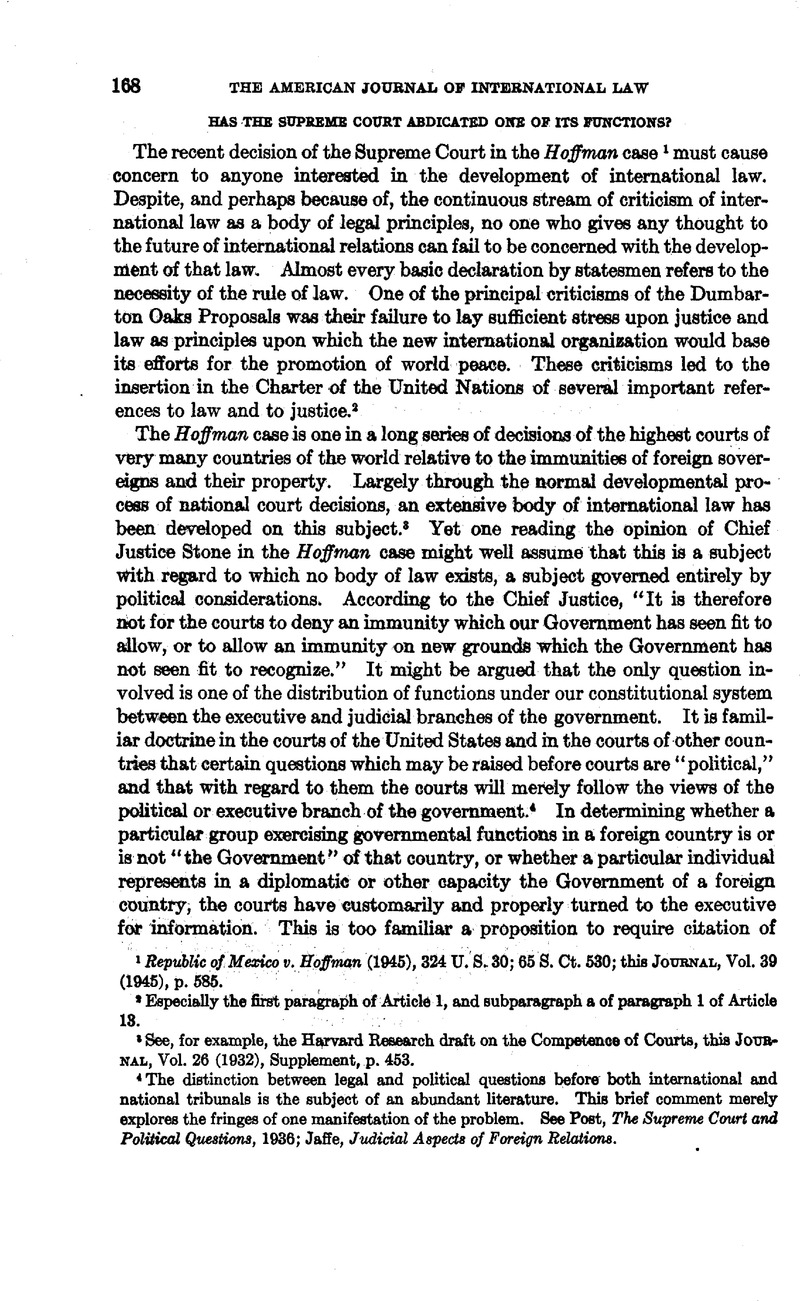Published online by Cambridge University Press: 20 April 2017

1 Republic of Mexico v. Hoffman (1945), 324 U. S. 30; 65 S. Ct. 530; this Journal,Vol. 39 (1945), p. 585.
2 Especially the first paragraph of Article 1, and subparagraph a of paragraph 1 of Article 18.
3 See, for example, the Harvard Research draft on the Competence of Courts, this Journal, Vol. 26 (1932), Supplement, p. 453.
4 The distinction between legal and political questions before both international and national tribunals is the subject of an abundant literature. This brief comment merely explores the fringes of one manifestation of the problem. See Post, The Supreme Court and Political Questions, 1936; Jaffe, Judicial Aspects of Foreign Relations.
5 See Deàk,, F., “The Plea of Sovereign Immunity and the New Yoric Court of Appeals,” in Columbia Law Review, Vol. XL (1940), p. 453 CrossRefGoogle Scholar.
6 Lord Sumner in Duff Development Co. Ltd. v. Government of Kelanian, House of Lords, [1924] A. C. 797. For varying positions relative to the determination of territorial questions, see The Fagemess, Court of Appeal, [1927] Probate, 311; discussed in British Year Book of International Law, Vol. 9 (1928), p. 120; Williams v. Suffolk Insurance Co. (1839) , 13 Pet. 415; Tartar Chemical Co. v. US (1902), 116F.726.
7 See the excellent statement of the Attorney General in Engelke v. Musmann, House of Lords, [1928] A.C. 483,436: “It is admitted, however, that such a statement [by the Secretary of State for Foreign Affairs concerning recognition of a person as a member of the diplomatic staff of a foreign ambassador] is conclusive upon the question of diplomatic status alone; and it is still for the court to determine as a matter of law whether, the diplomatic status having been conclusively proved, immunity from process necessarily follows.”
8 This seems to mark a departure from the position taken by Chief Justice Stone in The Navemar (1938), 303 U. S. 68, 75: “The Department of State having declined to act, the want of admirality jurisdiction because of the alleged public status of the vessel and the right of the Spanish Government to demand possession of the vessel as owner if it so elected, were appropriate subjects for judicial inquiry upon proof of the matters alleged.”
9 See the numerous examples in Green Hackworth, Digest of International Law, Vol. II, Chap. VII.
10 1926, L.N.T.S., No. 1192.
11 Ex-parte Republic of Peru (1943), 318 U. S. 578, 589. Hyde,, C. C., International Law, 1945 (2d ed.), Vol. II, pp. 912–913 Google Scholar.
12 Hyde, work cited, Vol. 3, Sec. 894.
13 House of Lords, [1938] A.C. 485. To same effect: Wright v. Cantrell (1943), Sup. Ct. of New South Wales, 44 State Reports N.S.W., 45, 46, and Chung Chi Cheung v. the King,Privy Council, [1939] A.C. 168.
14 (1900), 175 U. S. 677.
15 InternationalLaw in National Courts, New York, 1932.
16 See particularly the statements of the Belgian Court of Cassation in the case of Princesse Stéphanie c. Le Baron Goffinet (1906), Pandectes Périodiques, Vol. I, 1.
17 30 Hogsheads of Sugar v. Boyle (1815), 9 Cranch. 191, 198.
18 Anderson v. N. V. Transandine Handelmaatschappij (194–), 289 N. Y. 0; this Joubnal, Vol. 36 (1943), p. 701.
19 U. S. v. Pink (1942), 315 U. S. 203; see this Journal, Vol. 36 (1942), p. 282, and the comments upon the inadequacy of the presentation of points of international law in the case of Guaranty Trust Co. v. U. S. (19—), 304 U. S. 126, this Journal, Vol. 32 (1938), p. 542. The effect of the decision in the Pink case upon the lower courts is brought out by the decision in The Maret (1944), 145 F. 2d 431.
20 Williams, J. F., La Doctrine de la Reconnaissance en Droit International et ses Développements Récents, in Recueil des Cours de l’Académie de Droit International, la Hayne, Vol. 44 (1933), p. 255 Google Scholar.
21 Russian Reinsurance Co. v. Stoddard (1925), 240 N. Y. 149, 158.
22 Mr. Justice Frankfurter recognized the need for these fundamental changes in a separate opinion in the Pink case when he said: “The opinions show both the English and the New York courts struggling to deal with these business consequences of major international complications through the application of traditional judicial concepts”: 315 U. S. 203, 235. It is respectfully suggested that the Supreme Court has not yet pointed the way to satisfactory new judicial concepts.
23 In addition to other cases referred to in this comment, the following cases in which opinions were delivered by members of the present bench of the Supreme Court, constitute contributions to international law: Jordan v. Toshiro (1928), 278 U. S. 123; Nielsen v. Johnson (1929), 279 U. S. 47; U. S. v. Flores, (1933) 289 U. S. 137; U. S. v. O'Donnell, (1939) 303 U. S. 601.
24 New Jersey v. Delaware (1934), 291 U. S. 361, 383.